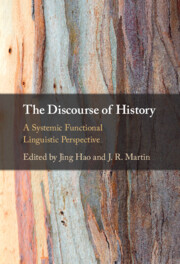Book contents
- The Discourse of History
- The Discourse of History
- Copyright page
- Contents
- Figures
- Tables
- Contributors
- Preface
- 1 Building Historical Knowledge through Language: A Systemic Functional Linguistic Perspective
- 2 Cultivating a Critical Gaze: Managing Technicality in Ancient History Teaching
- 3 Cultivating the Value of Democracy in History Teaching
- 4 Interpreting History: Valuing Events in a Postcolonial World
- 5 Coordinating Meaning: Scaffolding Teaching/Learning in Pedagogic Discourse
- 6 Explaining What Happened: Logical Metaphors in Spanish History Textbooks
- 7 Negotiating Values through Historical Evidence
- 8 Historical Empathy: Learning to Care about Others’ Suffering through Film
- 9 History in the Arts: Exploring the Past to Cultivate Students’ Gaze
- 10 Describing and Taxonomising the Phenomena of a Glorious Past
- 11 Representing Minority History in a Multi-Ethnic Country
- 12 Expressing Attitudes in Ancient Chinese History
- References
- Index
6 - Explaining What Happened: Logical Metaphors in Spanish History Textbooks
Published online by Cambridge University Press: 16 May 2024
- The Discourse of History
- The Discourse of History
- Copyright page
- Contents
- Figures
- Tables
- Contributors
- Preface
- 1 Building Historical Knowledge through Language: A Systemic Functional Linguistic Perspective
- 2 Cultivating a Critical Gaze: Managing Technicality in Ancient History Teaching
- 3 Cultivating the Value of Democracy in History Teaching
- 4 Interpreting History: Valuing Events in a Postcolonial World
- 5 Coordinating Meaning: Scaffolding Teaching/Learning in Pedagogic Discourse
- 6 Explaining What Happened: Logical Metaphors in Spanish History Textbooks
- 7 Negotiating Values through Historical Evidence
- 8 Historical Empathy: Learning to Care about Others’ Suffering through Film
- 9 History in the Arts: Exploring the Past to Cultivate Students’ Gaze
- 10 Describing and Taxonomising the Phenomena of a Glorious Past
- 11 Representing Minority History in a Multi-Ethnic Country
- 12 Expressing Attitudes in Ancient Chinese History
- References
- Index
Summary
This chapter explores how written Spanish is used to construe causality in history discourse. It particularly examines the realisation of sequences in a Chilean secondary school textbook, when dealing with the implementation of neoliberalism in Chile. The study shows that the official teaching material draws heavily on logical metaphors to construe sequences. Owing to its focus on discourse semantics, this work offers clear criteria for identifying different types of logical metaphors, beyond the isolated causal lexis that might be found in a text. Based on different combinations of figures and connexions, realisations of sequence are scaled from the most congruent to the least congruent. Thus, the chapter delves into the lexicogrammatical particularities of written Spanish to metaphorically realise connexions. In addition, it reveals that logical metaphors interact with other discourse semantic systems and, therefore, make an enlarged meaning potential available for writers in history texts.
Information
- Type
- Chapter
- Information
- The Discourse of HistoryA Systemic Functional Linguistic Perspective, pp. 116 - 144Publisher: Cambridge University PressPrint publication year: 2024
